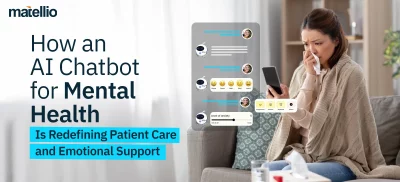
In the present era of the digital revolution, an incredible kind of human-computer interaction with the exponential growth of information technology and communication has been ignited. Furthermore, recent developments in the IoT ( Internet of things) with the accelerated growth of cloud and artificial intelligence technology has immensely dominated the healthcare sector. Since computational power has fuelled up, storage space prices have dropped and electronic components have assisted in developing a new kind of health wearable devices.
These health and well-being wearable devices monitor one’s behaviours and obtain insights from collected data. Furthermore, today wearable app development proffers activity tracking and the functional sensing of biometric information like body temperature and heart rate. With an additional advantage of sensory data to decide user’s actual state of mind, it encapsulates the traits of mobility and connectivity to give access to the user of respective information with the utmost convenience and to communicate it immediately with others while moving. The rate at which users have adopted new devices or products is directly proportional to the relative advantage from the product with integrated attributes. According to the IDC ( International Data Corporation), the market of healthcare wearable has been escalating around 30% annually while by 2020, it is highly expected to reach $18.9 billion.
What is Wearable Technology?

Wearable’s or wearable devices are electronic devices that can be worn over the body to accumulate various different purpose. The wearable device architecture comprises of the user interface, a sensor, and an internet network that makes these unobtrusive and user-friendly. Currently, wearable devices are not limited to fitness bands and smartwatches but it extends to the needs of healthcare organizations or their patients through highly integrated companion app saddled through cross-platform app development, So, let’s have an un-exhaustive list of the wearables:
1. Smart Clothing
2. Smart Pill
3. Back Therapy Wearable
4. Health Track Wearable
5. Glucose Monitoring Wearable
1. Smart Clothing
The concept of smart clothing came into existence in 2015, and still leveraged as a mainstream activity. As innovative companies continue to thrive, the demand for healthcare technology consulting services has gone high, as many are integrating technology directly into their fabrics. It offers more than those strapping gadgets, as it enables constant tracking of heart rate, monitors emotions, respiratory rate, temperature, and blood oxygen saturation. Some of the highly used devices are Smart sleeve, Smart Socks, Smart shirt and many more.
2. Smart Pill
It basically focused on diagnostic imaging and wireless patient monitoring. The system includes a pill, a Smartphone, and a sensor patch where the pill encapsulates the sensor coated with copper and magnesium. Basically, these metals are the part of the routine diet and also available in multivitamin supplements, its consumption would not be harmful to the person. The next minute one swallow the pill the sensor gets activated within the body by electrolytes. Then signals transmit from the pill to a worn patch by the user and send the collected data to the physician or user’s family member’s smartphone via Bluetooth.
3. Back Therapy Wearable
It is basically designed for the people suffering from lower back pain issue. The device encapsulates a double pair of operative smart sensors for storing information in real-time which is accessed through the companion mobile or tablet applications run on Bluetooth smart technology. It further tracks progress and performance, precision and accuracy of moves and share that results with the therapist. Due to the effective cost technique, these companion apps have been also developed through cross-platform app development companies, which implements a robust and smooth function for the patient as well as for doctor.
4. Health Track Wearable
The technology has been introduced for healthcare professionals which makes them able to keep a check on the patient’s key information. It consists of a reusable biosensor which is embedded in a patch that can be easily disposed of and detects Heart rate, breathing, temperature, steps taken, and body position if a person falls.
Also Read- Wellness Tracker App Development: Latest Trends, Technologies and Features
5. Glucose Monitoring Wearable
Its a glucose monitoring system for all the people who are suffering from diabetes and eliminates the requirement for the finger prick system used for glucose testing. Glucose Monitoring Wearable reads glucose information from the placed sensor on the back of the upper arm from 14 days. Its companion app provides details about the food is taken or to be taken and proper exercises and dieting to the patient.
Also Read: Discover how AI in Pediatric Healthcare is transforming child-centric medical services with custom AI solutions, enhancing diagnostics, treatment, and patient care.
How is Wearable Technology influencing Healthcare?
The healthcare industry has whimsically dominated by wearable technology over the years due to the ageing population, growing health awareness and changing the perception towards preventive healthcare. Today the Smart Healthcare system is leveraged with highly skilled medical professionals and the cost-competitive attitude adopted by wearable app development companies. As a result, an individual can be delegated accountability to monitor and diagnose own health by using wearable devices connected with the mobile apps for alert notifications. That’s why major market players keep on venturing into wearable technology on a huge scale which undoubtedly unveils its significance.
1. The Unparallel Advantage for the Patient
2. Mitigated Medical Expenses
3. Efficacious for Doctors
4. Improved Current Scenario
5. Multi-dimensional Functioning
1. The Unparallel Advantage for the Patient
It has successfully proved as a boon for the patients who really need constant monitoring due to chronic conditions. It enables the doctors to recollect and reassures the medical data for gathering an accurate condition of the patient. Patients use patches that can easily be placed on their skin to accumulate relevant real-time medical-grade data to draw an unfeigned result. It also plays an alternative to hospitalization of the patient who needs to be monitored every hour as it recorded all information and can be analyzed for further diagnosis.
2. Mitigated Medical Expenses
With no need for verifying the truth that visits the hospitals cost patients more money through heavy consultation fee and other expenses and time, wearable helped in bringing down the heavy healthcare expenditure. Basically, it encompasses the benefits for the patients suffering from conditions like diabetes, hypertension, blood pressure, that needs regular evaluations. It ensures the early diagnosis of a patient’s health condition which makes treatment easier and mitigates their treatment expenditure as well as ignored complications.
3. Efficacious for Doctors
Generally, doctors find it much easier to diagnose the current condition with available real-time data to them. The accumulated relevant data assists in understanding the actual intensity of the caused condition and in taking prioritized cases after it. Surgeons have experienced the use of these wearables like Google Glass in cases of complicated surgeries and superimpose ultrasound images and CT scan on the selected area for an accurate picture. Most enterprises inclined to hire an app developer for authentic real time data extraction and diagnosis.
4. Improved Current Scenario
Small wearable devices have transformed the people lifestyle habits with a feature like tracking of their heartbeats, sleep patterns, etc, basic understanding and monitoring the routine activity level. These healthcare wearable devices come up with periodic reminders for staying active. It would help in transforming the current remodeled scenario where age-related issues have been common in the youth.
5. Multi-dimensional Functioning
The outspoken user-friendly development process of Wearable technology by mobile app development companies ensured uninterrupted fulfillment of fundamental need and purpose of the healthcare industries by monitoring data and keep sending it to the physician. These devices function so seamless that it also predicts an imminent emergency and simultaneously alert the patient and the concerned doctor and this would enable the doctor to keep all medical facilities complete and ready.
Also Read: Discover how AI in Diabetes Management can revolutionize diabetes care with customized strategies, improving patient outcomes and enhancing healthcare efficiency.

How can Matellio help with the Wearable App Development?
Wearable app development is more than just counting the steps, heartbeats and measure the blood pressure. According to analytics from IDTechEx, the wearable mobile app development market is expected to rise 23 percent by 2023 and cross $100 billion, while impacting all industries such as Lifestyle, medicine, music and gaming significantly. The rise of wearable devices is getting smaller and flexible with the time, where developing and designing the embedded devices needs to accommodate all sensors used for data capturing in powerful hardware. Matellio has expertise in the development of high speed embedded hardware devices such as Hybrid Smartwatch, Fitness watch and SoS watch. The company aims to provide a better compact and futuristic powerful solution.



